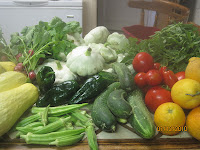It's harvest time, and everything seems to be ready to pick at once! Peaches, tomatoes, peppers, corn, berries, figs, herbs, greens and more. The farmers' markets are brimming with all kinds of ripe fruits and veggies--an prices may come down a little. Now's the time to look for deals.
Here in our Southern California garden, we don't have to worry about putting up part of the harvest to get us through the winter (we grow things all winter long), but we do have a surplus from time to time and have to make a choice as to how we will preserve or store the bounty. We can't eat it all before it begins to spoil.
One preferred choice is to give away at least some of our "extras" storing up treasure in heaven, and enjoyment and good will in our neighbors and friends.
Another choice is to sell or trade our excess. Selling is in effect storing the food in the form of money to be traded for food in the future. We could also trade with friends and neighbors who have surplus in areas we do not--the community concept. The advantage here is that we can get some of the other things we need or want by trading our extras.
A third choice is to preserve the bounty by canning, freezing, pickling, or drying. (More choices to make!)
Canning, or more accurately, "jarring," is a lot of work and extra heat in the house--something quite undesirable in the late summer heat. Canning, because of the cooking required, removes nutrients, taste, and texture from the food. Compare the taste of grocery store canned peas or green beans or asparagus compared to their freshly prepared counterparts. Well, there is no comparison. One advantage of canning however, is that no further energy is required for storage, unlike freezer-stored foods.
Freezing requires almost as much heat and work as canning. To preserve texture and taste most foods destined for the deep freeze need to be heated and then blanched in cold or ice water before being flash frozen (in single layers on trays), and then packed for the long freeze. Advantages include usually better flavor and texture than canned produce and a little less time an heat in the kitchen for preparation. The big disadvantages: limited space in the freezer and the energy to run it.
Pickling produces yummy and nutritious results, but requires a fridge or root-cellar-type-arrangement for long-term storage. In our part of the world, root cellars are pretty rare. If kept reasonably cool, sauerkraut, for example, will keep for many months, even years (ask Captain Cook's crew), but taste and texture will suffer. Nobody wants to bite into a soggy tasteless dill pickle, which is what you'll have if you leave your pickle jar on the counter. Eventually pickles will begin to breakdown. Cold or at least cooler temperatures are required for long-term (over winter) storage.
That leaves drying or dehydrating, and there are at least three ways to go here. (Still more choices to make!). The keys to food drying are good air circulation and high enough temperatures to dry the food quickly. Any of the following methods will work, but some are more convenient to use, or faster or can be used indoors or outdoors.
You could heat up the house some more and oven-dry your harvest, placing thin slices or small pieces of your extras on cookie sheets or other trays in an oven set on a very low setting. So that moisture can escape the food and the oven, the door should be left slightly open--more heat in the already very warm house. Our oven's lowest setting is 200 degrees F, much higher than is needed.
Another choice is solar drying. Whether you use window screens as trays and covers for your produce or a more elaborate setup, avoid putting your dehydrator any place where air pollution or anything else in the air could taint your produce. One major drawback to a solar dryer is that it will not work indoors. If a summer storm comes over, you'll be scrambling to move or cover your dryer setup and therefore putting the drying on hold.
Our favorite way is to use an electric dehydrator. We have used three different styles and can say confidently that not all dehydrators are created equal.
Years ago we had a dehydrator that was powered by a single light bulb. It did its job, but the heat was constant (not adjustable) and not very even throughout. There were three or four small racks for the food, which we had to rotate so that everything would dry evenly.
We then graduated to an
American Harvest Food Dehydrator
made by Nesco. This dehydrator heats the food evenly and has good air flow. The heating element (adjustable) and fan (also adjustable in earlier models) are in the base. The round, stacking trays fit together to make channels through which the air flows. The only drawback we see in this dehydrator is that the distance between the trays is not adjustable.

Our favorite dehydrator is the
Excalibur. The drying trays slide into its cabinet, allowing for more space between trays if necessary. Removing all trays allows the dehydrator to be used as a yogurt maker. For our family it is handy to make yogurt in half-gallon jars which our
nine-tray model will accommodate. The
five-tray model will hold quart jars. We have also used our dehydrator as a proofing box for bread and pizza dough.
How we use our dehydrators most often (in order of frequency):
- Making yogurt (about once a week)
- Drying herbs.
- Making Crispy Nuts.
- Drying fruits and veggies from the garden or farmers' market.
- Drying homemade pasta.
Our tastiest use of our dehydrators: beef jerky!























 This post is also available at The Swanson Family Web Site: dcs1225.com
This post is also available at The Swanson Family Web Site: dcs1225.com



